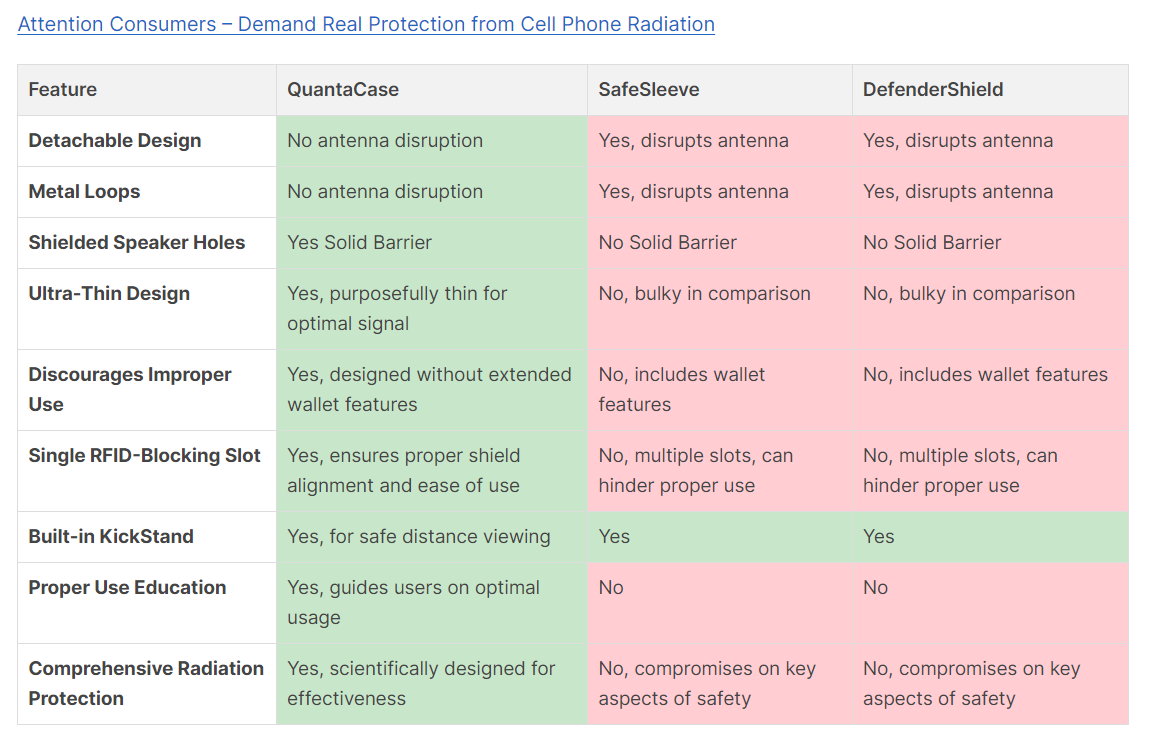
For over 25 years, RF Safe Approved designs have consistently upheld the highest standards without compromise. Our commitment to your safety is unwavering: you'll never find metal loops or metal plates for detachable functionality in our products. #RFSafe #RadiationProtection
RF Safe introduced the world to the use of anti-radiation phone cases in the 1990s. However, these cases that have copied RF Safe's decades-old product design aren't replicating the end result of safer consumers or providing the protection they claim. Let's delve into how to distinguish between genuine and fake anti-radiation phone cases, focusing on three critical design flaws that start with metal loops, magnetic detachable designs with metal plates, and unshielded speaker holes!
| Anti-Radiation Features Some Leading Brands Don't Support | QuantaCase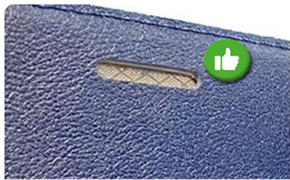 |
SafeSleeve |
DefenderShield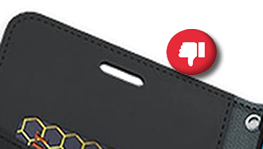 |
|---|---|---|---|
| Shielded Speaker Hole | Yes, ensuring no holes in radiation protection. | No, leaves a gap in protection aligned with ear canal. | No, compromising the shielding effectiveness. |
| Metal Carrying Strap Loops | No, avoids any interference from metal elements. | Yes, metal loops create unpredictable radiation patterns. | Yes, includes metal loops that can interfere with radiation shielding. |
Red Flag #1: Presence of Metal Loops
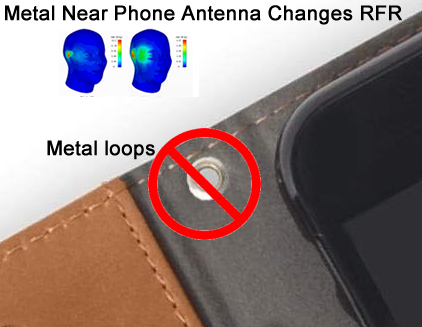 The Misconception:
The Misconception:
- Some anti-radiation phone cases come equipped with metal loops for carrying straps, but this is a major design flaw.
- Research indicates that metals can alter radiation patterns. For instance, metal eyeglass frames have been shown to affect the way radiation is absorbed by the body.
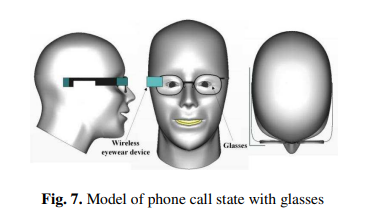
- Similarly, metal loops on phone cases can unpredictably alter the propagation of electromagnetic waves.
- If a manufacturer includes metal loops, it suggests a fundamental misunderstanding of electromagnetic fields (EMFs) and how mobile phones operate.
- Renowned initiatives like RF Safe advise against incorporating metal components in case designs which can affect microwave transmissions in a negative way. Such elements can interfere with a phone’s antenna and its radiation emission patterns. Experts with decades of experience are available for free consultations at rfsafe.com - Call the RF Safe toll-free number to get up-to-date and informed.
Red Flag #2: Detachable Designs with Metal and Magnets
The Issue:- Phone cases with a magnetic detachable design often utilize large metal plates and magnets, which pose a significant problem.
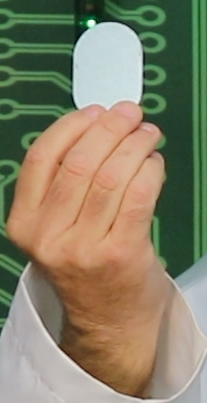
- These metal parts can and will obstruct the phone's antenna, leading to altered signal transmission.
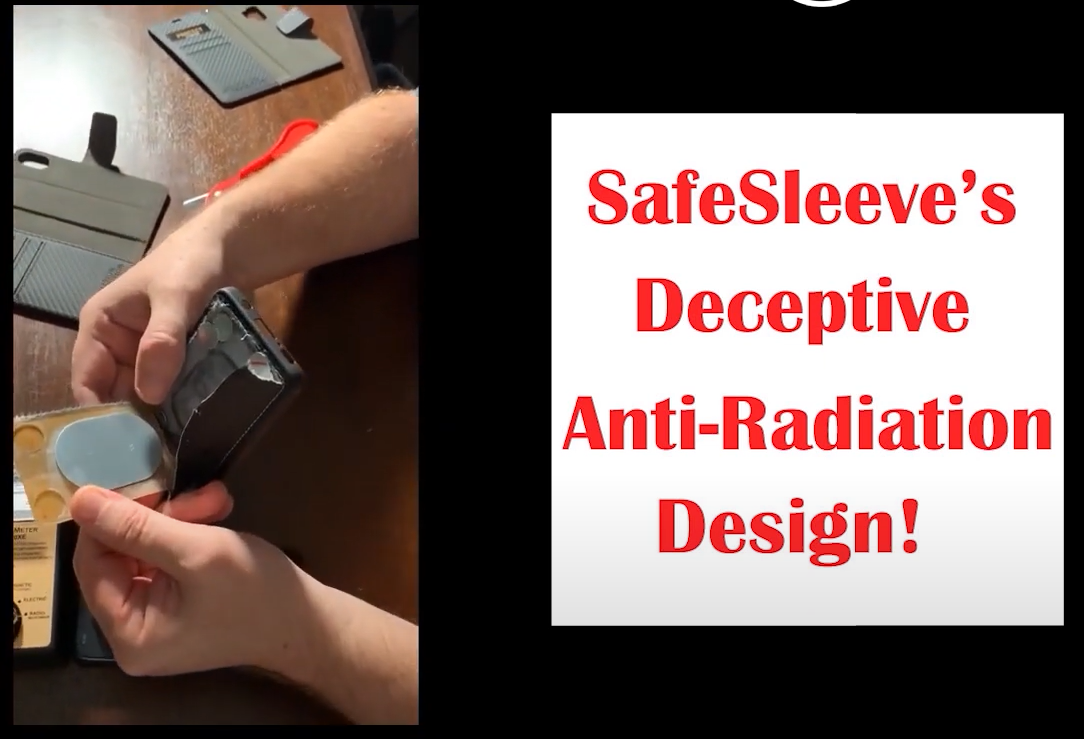
- A blocked signal often prompts the phone to ramp up its radiation output to maintain connectivity with the cell tower.
- Cell Phone Users Beware: Study Finds Weak Signal Strength Can Increase Microwave Radiation Exposure 10,000-Fold
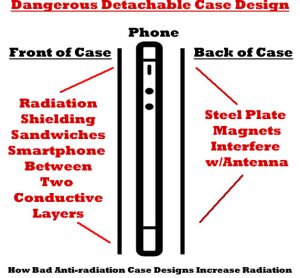
- Essentially, such designs are in direct contradiction to the fundamental principles of radiation protection.
- By obstructing your phone's normal functionality, these cases can and will increase your radiation exposure, doing the opposite of what they promise.
Key Takeaways for Making a Safe Selection:
- Educate Yourself: A basic understanding of how anti-radiation materials work can guide your decision-making.
- Scrutinize the Design: Choose cases that utilize proven shielding materials and are designed to reduce exposure without compromising phone functionality.
- Avoid Designs with Metal Loops and Detachable Parts: These are clear indicators of a product that may not provide adequate protection.
- Consult Professionals: When in doubt, seek advice from RF safety experts in health or technology.
The 3rd Red Flag
In addition to the previous red flags, there's another crucial aspect to consider when evaluating the authenticity of anti-radiation phone cases: the claims of protection percentage.
Red Flag #3: Unrealistic Claims of Protection
For over a quarter of a century, RF Safe has stood by the creed that percentages can be deceptive. Instead of dangling the allure of "99% protection," the focus is on real-world applications. It's not just about the shielding; it's about case design and how you use it. The mastery behind RF Safe's design ensures the highest reduction of RF exposure, tailored to the way you live and communicate. Remember, no case is a substitute for distance, but in those moments when your phone has to be close, RF Safe is your best bet for minimizing risk.The Misleading Claim:
- Some anti-radiation cases tout a protection level of 99%. However, these claims can be very misleading and give a false sense of security.
- Even if a material can theoretically block 99% of radiation, it doesn’t equate to 99% protection in everyday use. RF Safe makes the best anti-radiation cases in the world, but don't take our word for it, over the span of decades, people have been testing RF Safe cases against every anti-radiation case ever made using all kinds of RF meters. Even as the most tested design, outperforming every case since RF Safe introduced its design standards online to the world in the 1990s as an open-source design at rfsafe.com. RF Safe has never used a percentage to convey a level of protection in over 25 years. Protection is always dependent on the user, and RF Safe's design is the most protective for reducing RF exposure when properly used. A protective anti-radiation phone case is not an alternative for distance but is a way to reduce exposure when distance isn't an option. It doesn't matter if the shielding can deflect 99% of the radiation if the manufacturer doesn't understand the principles of controlling RF Radiation from a phone.
- A useful analogy is the concept of shadows. Shadows are not complete voids of light but areas with reduced direct light. Similarly, claiming 99% protection based solely on shielding capacity is an oversimplification and 100% misleading.
Red Flag #4: Unshielded Speaker Holes
The Design Flaw:
A common oversight in many anti-radiation cases is the presence of unshielded speaker holes. These unshielded areas can significantly compromise the case’s ability to shield against high-frequency radiation, particularly in the upper 5G spectrum.
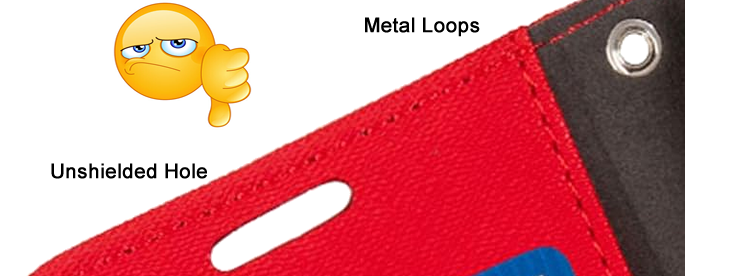
The Science Behind It:
As we progress to 5G and beyond, wavelengths become shorter. A case with a large, unshielded hole for the speaker in the front cover can't effectively block these shorter wavelengths. The signals can easily pass through, rendering the shielding ineffective. This is especially concerning because these holes are often aligned with the ear canal, a part of the head not directly protected by the skull.
The Implications:
Using a case with an unshielded speaker hole could expose you to higher levels of radiation, especially from 5G networks. This weak spot in the case's design could undermine the overall protection it offers.
Key Takeaways for Identifying Genuine Protection:
- Watch Out for Speaker Holes: Avoid cases with large, unshielded speaker holes as they can be a significant vulnerability in radiation protection.
- Understand the Implications: Recognize the importance of shielding against high-frequency radiation, especially with the advent of 5G technology.
- Seek Innovative Solutions: Opt for cases like QuantaCase that have adapted their design to provide effective protection against the latest communication technologies.
- Prioritize Comprehensive Protection: Choose a case that offers consistent shielding, without leaving any part of your phone shielding compromised by holes.
Genuine Anti-Radiation Phone Cases

A genuine anti-radiation case will not raise any RFR mitigation design flags
The QuantaCase Difference:
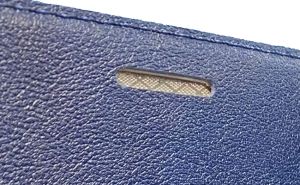
QuantaCase addresses this speaker hole issue with a specially designed shielded speaker hole, making it suitable for the 5G era. This design ensures that even the high-frequency wavelengths of 5G and satellite communications have no holes in the front cover shielded area. The case’s design allows users to easily verify the shielding’s effectiveness using an Ohmmeter, a level of transparency not often found in competitor cases. The QuantaCase uses the front cover speaker hole for you to access the shielding material with an Ohm meter for easy conductivity testing.

